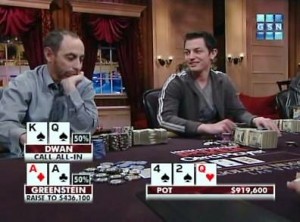 During the Poker Boom you would be hard pressed to find a time of the day where you could flip through the channels and not find at least one poker show airing. That’s not the case anymore though. Nowadays, if you’re looking for regularly scheduled poker shows the pickings are slim.
During the Poker Boom you would be hard pressed to find a time of the day where you could flip through the channels and not find at least one poker show airing. That’s not the case anymore though. Nowadays, if you’re looking for regularly scheduled poker shows the pickings are slim.
In this column I’ll discuss whether this decline is a product of UIGEA and Black Friday, or if it’s more an issue with poker programming in general?
The peak
At one point in time the World Poker Tour was the highest rated show on the Travel Channel (and the reruns of these episodes sometimes had higher ratings) and ESPN was televising virtually every event from the World Series of Poker –Stud, PLO, you name it—and even WSOP Circuit stops.
This was in addition to the abundance of other poker shows one might find as well: High Stakes Poker, Poker After Dark, Celebrity Poker Showdown, Poker Superstars Invitational, National Heads-Up Poker Championships, as well as regional events like the Heartland Poker Tour, the Eastern Poker Tour, and so on.
Point being, from about 2004 onward, poker was everywhere on TV.
The descent into the valley
The decline started earlier than many people may remember, as early as 2007, and by 2011 the writing was clearly written on the wall for all to see; poker and TV may have still been still been married in 2011, but they were sleeping in separate beds and barely exchanging pleasantries with one another.
By this time most poker programs were funding themselves, and advertisers were few and far between, and very limited in their scope. ESPN had cut back its WSOP coverage to the Main Event and a couple other tournaments, and the WPT had moved from the Travel Channel to FOX Sports.
I can think of at least three factors that led to this decline:
Oversaturation led to staleness
As mentioned above, there were simply too many poker shows, and at some point the general public realized poker had nothing new to offer. Every story line had been played out multiple times (the rank amateur wins, the best in the game proves why, the redemption story) and most viewers simply flipped the channel thinking, “Been there done that.”
Similar products
In addition to the staleness every poker show looked exactly the same. The setup was pretty consistent; the hole-card display was near universal; the commentary was similar; and even the players started dressing the same.
Most viewers landing on the final table of some poker tournament probably had no idea if they were watching a new episode or a rerun of an older broadcast.
Regular cycle of things
Of course, it could simply have been a case of poker’s lifespan having come to an end. Even the highest rated TV shows don’t last forever, so poker’s fall from grace could very well have been caused by nothing more than the regular cycle of TV trends.
The coup de grace
When Black Friday hit in April of 2011, cutting off the few remaining sponsors (namely the offshore online poker sites), the divorce was pretty much finalized and the TV era for poker was pretty much over.
On the bright side, the reality of the situation is that Black Friday probably put televised poker out if its misery, and without Black Friday televised poker would be in an even worse place than it is today.
At least now, if someone comes up with a new innovative idea for a televised poker show they can approach the networks and say “if not for Black Friday,” whereas if poker was left to wither on the vine the networks wouldn’t touch it going forward. The fact that it all ended so abruptly may be the only saving grace for televised poker.
The remnants
Right now the only consistent products still on TV are the World Series of Poker, the World Poker Tour, and the Heartland Poker Tour. NBC has decided not to host the National Heads-UP Championship this year, likely signaling the end of the only major network poker product left, and there doesn’t seem to be any projects on the horizon.
What this means for poker players going forward
Without a desirable media product poker is unlikely to make a comeback on television.
The live stream hasn’t been the answer, and thus far every offshoot (which has included amateurs vs. pros, reality TV, as well as game show type settings) has been met with a general sense of malaise from viewers on both sides of the aisle –professional players and enthusiasts and casual viewers.
Without televised poker the opportunity for sponsorships will never be what it once was during the Poker Boom. And let’s not kid ourselves; it was sponsorships that allowed a lot of one-trick ponies to call themselves poker pros for five or more years.
Because of this we may see poker revert back to its roots, where cash games were the bread and butter of professional players, and tournaments were just a way to take a flyer on a potential big score. Before the Poker Boom I’d never even heard of a “Tournament Pro” and I have a feeling players are going to have to either learn to play cash games to supplement their tournament variance, or stick solely to online, because without the sponsorship money there isn’t much of a future as a live tournament specialist.
100% up to $3,000 Bonus
Bovada is our most recommended ONLINE CASINO and POKER ROOM for US players with excellent deposit options. Get your 100% signup bonus today.


Leave a Reply
You must be logged in to post a comment.